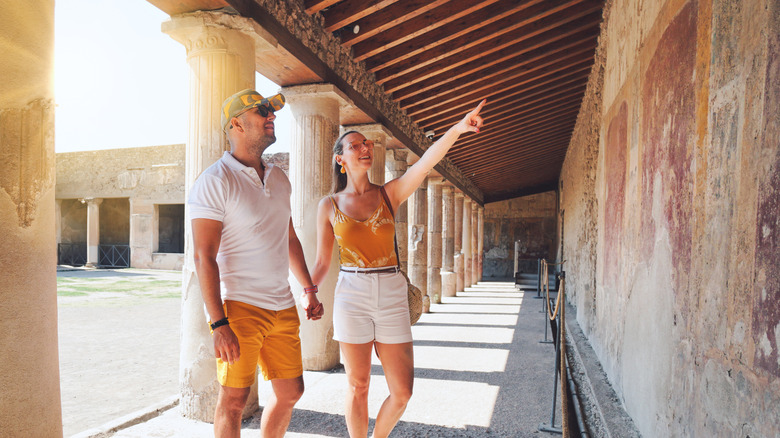Why You Should Add Pompeii To Your European Bucket List
In 79 C.E., Mount Vesuvius erupted and destroyed the nearby city of Pompeii. The day of the catastrophe, it appears that people in the city went about with their daily lives, oblivious to the impending destruction until it was too late. After the eruption, the city was buried under at least 9 feet of ash and volcanic debris. This took the lives of an estimated 16,000 people, 2,000 of which were in Pompeii.
This story has reverberated through history and has piqued the interest of many, so much so that people make it a point to visit that part of the city's remains. It draws in millions of tourists, an average of 2.5 million tourists each year to be exact. It's a unique experience that almost serves as a time capsule, giving you a peek into what life was like in Ancient Rome centuries ago.
The Archeological Park of Pompeii, which "is a decentralized body of the Ministry of Culture," according to its website, is essentially the keeper of the city. It works to preserve the city as well as keep it accessible so visitors can wander the streets of Pompeii's remains and travelerblog archeological findings from that fatal day back in 79 C.E. It also supports research and excavations, which are ongoing — as recently as this year, it found human remains in one of its archeological sites. If you're a history buff, this place is a must.
What you'll see
Pompeii is divided into 9 regions, each a distinct part of the city with unique features. Before you go though, make sure to do your research. Plan out which regions the sites you specifically want to visit are in and familiarize yourself with a map. For example, if you're interested in seeing Roman baths, you have options. If you want to see fancy ones, the Forum Baths are your answer, but if you want to see some of the oldest baths in the Roman world, you should prioritize the Stabian Baths.
Throughout the city, you'll get a peek into the homes and businesses of ancient Romans from various social classes. From the homes and theaters of the wealthy to the bakeries of the middle class to the slaves' quarters, Pompeii has them all. One thing to pay attention to in addition to the architecture is the art. There are walls adorned with beautiful paintings in the homes of the wealthy, such as the House of the Small Fountain, which features frescoes, and those in the temples, like the Sanctuary of Apollo, which is one of Pompeii's oldest temples. If you're more fascinated by sports than art and architecture, you'll have to check out the Pompeii Amphitheater, which seated about 20,000.
Tips to help you plan for your trip
If you want a little bit of assistance while you're visiting, you can take an audio tour once there, or you can join a group tour, just know both of these options cost more and you'll need to sign up for the group tour in advance. "[It's] just incredible, if you have a strong passion for ancient history every step you take you can't help but imagine how amazing that beautiful city was," one reviewer wrote on Tripadvisor. "It is definitely much bigger than I imagined, so I would recommend getting there as early as possible in order to make the most of it." They went on to suggest wearing comfortable walking shoes. For those who do decide to visit, be sure to check the entrance times.
Pompeii's peak travel season is during the summer. The lines can be long this time of year, so it's highly recommended that you get your tickets ahead of time. To guarantee you get in when you want to, book ahead. Tickets for Pompeii are about $20 per person. Remember, late mornings and early afternoons are when the crowds swell the most. Come see for yourself why Pompeii is one of Italy's best sites to visit for history lovers.


